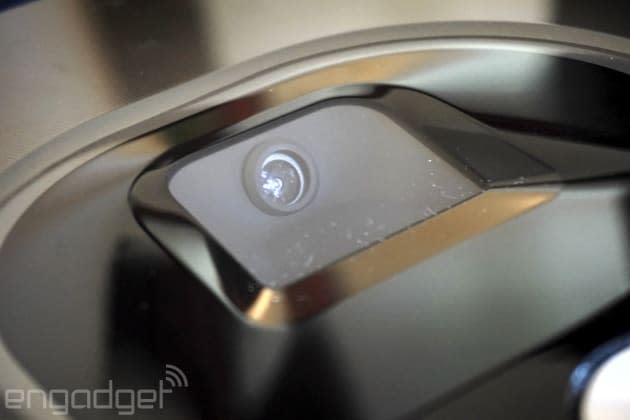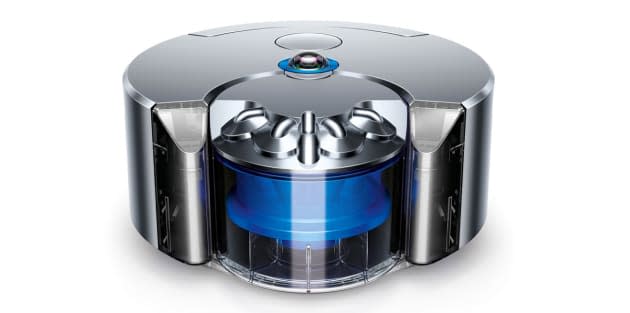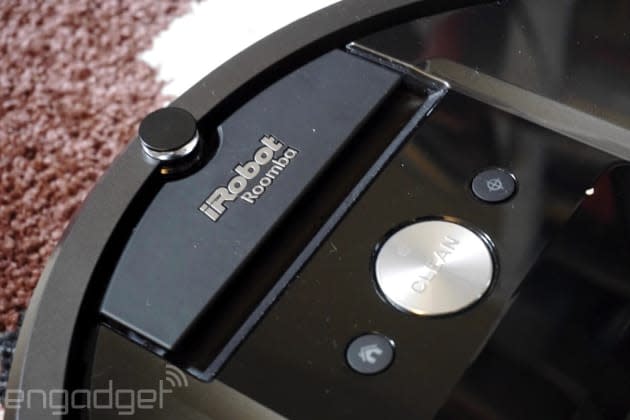Roomba 980 review: iRobot's best vacuum yet, but too pricey for most

It's 2015 and I'm still waiting for Rosie the Robot, or some sort of equivalent home bot, to clean my home. We're probably years away from a Jetsons-like future, but it's easy to forget that iRobot's Roomba has already been around for over 13 years now, steadily getting better at doing your dirty work. Now with the new Roomba 980, iRobot is making its vacuum-cleaning bot smarter than ever before -- so much so that it's calling the 980 the most important Roomba since it first debuted in 2002. It has a camera and advanced localization technology that allows it to see obstacles and map your floors, and for the first time, it's also wirelessly connected and works together with a mobile app. Most importantly, it finally rid my carpets of cat hair. The 980 is the best Roomba yet, plain and simple. Unfortunately, its high cost of $900 puts it out of reach for most people.
Hardware and design

If you haven't paid close attention to Roombas over the past few years, you won't initially notice much different about the 980. It has the same circular, low-profile design that iRobot has been refining for years. Look a bit closer, though, and you'll notice a small camera on its top. On the bottom, you have the same two "AeroForce" extractors as the Roomba 880, which allows it to clean your floors without traditional brushes, as well as the same large trash bin with removable HEPA filters. One interesting difference from other Roombas: The 980 feels significantly heavier, mainly due to all of the additional hardware inside of it.
What hardware, you ask? The Roomba 980 is iRobot's first consumer device to include its "visual simultaneous localization and mapping" (vSLAM) technology, which was previously relegated to its more expensive enterprise offerings, like the Ava telepresence robot. Using a combination of the top camera and a floor sensor, it can track where it's been in your home by locating visual landmarks, and it can also avoid obstacles along the way. That technology is also the centerpiece of iRobot's new iAdapt 2.0 navigation solution, which allows the 980 to maneuver around your home more easily.

With all of its new mapping technology, iRobot claims the 980 can clean an entire floor of your home on its own. And if it doesn't finish the job, it can also return to its charging base, juice up and head back out to work. The Roomba 980 is also a lot smarter when it comes to cleaning: It can detect when it's on carpet and increase its power to gather up more dust. And when it's on hardwood floors, it's also quieter than previous models.
This new Roomba finally brings something fans have been wanting for some time: WiFi support, and a companion app. You can use the app to start and stop cleaning sessions remotely, as well as manage your Roomba's schedule. It also keeps a history of all your past cleaning jobs, which is particularly useful if you're not home to see Roomba work. iRobot reps told us that many consumers never used the scheduling feature on previous models because it required fiddling with buttons and menus right on the Roomba, using archaic menus. (I'm guilty of that, as well.)
In use

I've been a Roomba owner for over a decade now, starting with a refurbished earlier model (I can't even remember the exact one), and most recently with a trusty Roomba 770. Over the years, iRobot dumped Roomba's brushes, improved the battery life and added HEPA filters. Otherwise, though, there weren't many groundbreaking changes. It's a shame, but it's understandable why many consumers aren't very excited about them -- none of the follow-up models were as exciting as the first. And the fact that they've typically been pretty expensive, making them more akin to toys for the elite, rather than something useful for everyone, doesn't help either. The Roomba 980 doesn't do much to alter that elitist perception, but it's notable because it represents a fundamental change in the way Roombas work.
But let's start from the beginning: As on other models, iRobot recommends that you charge the 980 for a bit after you get it out of the box. It ships with the battery charged to 40 percent, though, so you can use it immediately if you're overeager. Connecting the 980 to WiFi is just a matter of downloading the iRobot Home app on your iPhone or Android phone, and following the steps to add a new Roomba. The process isn't exactly seamless; you've got to connect to the Roomba's WiFi network, and then add in the credentials of your home WiFi setup, all the while hopping between your phone's setting screen. I was able to get it connected to my home network in around five minutes.
You don't need to have your Roomba 980 connected to WiFi to use it, but it's worth doing. Even if you don't plan to control it remotely, or set a schedule, it's still helpful to see the results of your cleaning jobs within the app. Hitting the big "Clean" button on the app generally starts a cleaning job within 10 to 15 seconds, depending on your WiFi network. The cleaning queue works just like a printer queue. If you have connectivity issues while trying to start the Roomba remotely, you might find yourself with several stacked cleaning jobs.
Instead of cleaning your floors in seemingly random patterns (which I'm sure make sense to robots), the 980 moves in straight, intelligent lines. It moved around obstacles in my home with ease, instead of just bumping into them endlessly. And it did a pretty great job of cleaning my floors too, especially a wool carpet in my bedroom that's basically a magnet for cat hair. It ended up collecting around twice as much debris as my Roomba 770, covering the same territory. And while it still sucks up some cables, they don't get jammed in the 980's rollers, whereas that was a constant issue with past Roombas.

All of its sensors do more than just help the Roomba 980 avoid furniture. After it runs through your house a few times, it'll also know where, exactly, it is in your home. If I start a cleaning job from my office, it'll work its way through my apartment, hitting my living room, dining alcove and foyer, until it reaches my bedroom. And if I start in the bedroom, it goes the opposite route. Most impressively, the Roomba 980 was able to maneuver through my apartment without any help on my part. My 770 would always get stuck cleaning one portion of my apartment repeatedly, which would force me to pick it up and drag it to a new room. The 980 is smart enough to move on when it needs to, and it knows exactly where to go. It's the first Roomba you won't need to babysit.
The app's scheduling feature is also a nice addition, especially if you like coming home to a clean house. The 980 didn't have any trouble following the schedule I set up, judging from the spotless carpet (and freaked-out cats) that I came home to. Of course, it can only clean effectively until its debris bin is full. If you have a large home, don't expect the Roomba to work magic.
The 980 takes about an hour to run through my entire apartment, slightly faster than the 770. But thanks to its new sensors, I also have more confidence that it actually cleans more thoroughly. I no longer have to bring it back to heavily soiled carpet spots, or nooks that it may have missed. It managed to run for a full two hours, which is what iRobot promised, but you'll have to be sure to keep it on its charging bay constantly if you want to use it on a whim. While the 980 is using newer lithium batteries, rather than the NiMH (nickel-metal hydride) batteries from previous models, it still loses its charge after a few days.
The competition

There's no shortage of competing robot vacuums: LG's RoboKing line has been on the market for years, and has sported cameras and advanced sensors for some time. Samsung, meanwhile, has the newly launched PowerBot, which seems to be a decent cleaner, but is also pretty expensive at around $900. But the most direct challenger to the Roomba 980 is Neato's Botvac Connected, which can also map your floors and can be controlled by a mobile app. It's also significantly cheaper than the 980 at $699. Dyson's upcoming 360 Eye (above) also looks to keep pace with the 980 sensor-wise, but it's only available in Japan right now.
Of course, iRobot's existing Roomba lineup includes decent alternatives, especially if you're looking to save a few bucks. The brushless Roomba 880, which cleans almost as well as the 980 but without the sensor smarts, is selling for around $625 now, while the 770 model is going for around $480. With the holiday season approaching, you can be sure older versions will be going on sale too to make way for new inventory. I managed to snag a 770 for around $400 last year, and I can only imagine it getting cheaper. Honestly, given the breadth of cheaper competition out there, it's a bit tough to stomach the Roomba 980's $900 price.
It's hard enough to extol the virtues of robot vacuums when they're around $500 -- for something closer to $1,000 it's practically impossible. As I was testing the 980 around AOL's offices, for example, it attracted plenty of onlookers who were intrigued by it, but were immediately turned off by the price. Or maybe they just couldn't justify spending nearly a half-month's rent on something to clean their tiny New York City apartment.
Wrap-up

There's no doubt that the Roomba 980 is iRobot's best vacuum yet. It's no longer just a dumb bot bouncing against the walls; it's like a military weapon with a mission to seek out and eliminate dirty floors. (Don't forget iRobot builds plenty of products for use by law enforcement and the military.) But at $900, it's not exactly a blind buy. If anything, though, the Roomba 980 is a great sign for the future of home robots. They'll need advanced cameras and mapping systems to maneuver around our homes, avoid obstacles and interact with us. The 980's price may be hard to stomach, but it's the clearest signal yet that advanced home robots aren't too far off.














